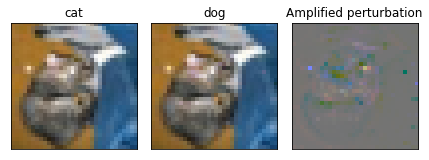2.9. Testing attacks against RobustBench models¶
In this tutorial, we will show how to correctly import RobustBench models inside SecML, and how to craft adversarial evasion attacks against them using SecML.
Warning
Requires installation of the pytorch extra dependency. See extra components for more information.
[1]:
%%capture --no-stderr --no-display
# NBVAL_IGNORE_OUTPUT
try:
import secml
import torch
except ImportError:
%pip install git+https://gitlab.com/secml/secml#egg=secml[pytorch]
We start by installing the models offered by RobustBench, a repository of pre-trained adversarially robust models, written in PyTorch. All the models are trained on CIFAR-10. To install the library, just open a terminal and execute the following command:
bash pip install git+https://github.com/RobustBench/robustbench.git@v0.1
[2]:
%%capture --no-stderr --no-display
# NBVAL_IGNORE_OUTPUT
try:
import robustbench
except ImportError:
%pip install git+https://github.com/RobustBench/robustbench.git@v0.1
After the installation, we can import the model we like among the one offered by the library (click here for the complete list):
[3]:
# NBVAL_IGNORE_OUTPUT
from robustbench.utils import load_model
from secml.utils import fm
from secml import settings
output_dir = fm.join(settings.SECML_MODELS_DIR, 'robustbench')
model = load_model(model_name='Carmon2019Unlabeled', norm='Linf', model_dir=output_dir)
This command will create a models directory inside the secml-data folder in your home directory, where it will download the desired model, specified by the model_name parameter. Since it is a PyTorch model, we can just load one sample from CIFAR-10 to test it.
[4]:
# NBVAL_IGNORE_OUTPUT
from secml.data.loader.c_dataloader_cifar import CDataLoaderCIFAR10
train_ds, test_ds = CDataLoaderCIFAR10().load()
[5]:
import torch
from secml.ml.features.normalization import CNormalizerMinMax
dataset_labels = ['airplane', 'automobile', 'bird', 'cat', 'deer', 'dog', 'frog', 'horse', 'ship', 'truck']
normalizer = CNormalizerMinMax().fit(train_ds.X)
pt = test_ds[0, :]
x0, y0 = pt.X, pt.Y
x0 = normalizer.transform(x0)
input_shape = (3, 32, 32)
x0_t = x0.tondarray().reshape(1, 3, 32, 32)
y_pred = model(torch.Tensor(x0_t))
print("Predicted classes: {0}".format(dataset_labels[y_pred.argmax(axis=1).item()]))
print("Real classes: {0}".format(dataset_labels[y0.item()]))
Predicted classes: cat
Real classes: cat
2.9.1. Load RobustBench models inside SecML¶
We can now import the pre-trained robust model inside SecML. Since these models are all coded in PyTorch, we just need to use the PyTorch wrapper of SecML.
In order to do this, we need to express the input_shape of the data, and feed the classifier with the flatten version of the array (under the hood, the framework will reconstruct the original shape):
[6]:
from secml.ml.classifiers import CClassifierPyTorch
secml_model = CClassifierPyTorch(model, input_shape=(3,32,32), pretrained=True)
y_pred = secml_model.predict(x0)
print("Predicted class: {0}".format(dataset_labels[y_pred.item()]))
Predicted class: cat
2.9.2. Computing evasion attacks¶
Now that we have imported the model inside SecML, we can compute attacks against it. We will use the iterative Projected Gradient Descent (PGD) attack, with l2 perturbation.
[7]:
from secml.adv.attacks.evasion import CAttackEvasionPGD
noise_type = 'l2' # Type of perturbation 'l1' or 'l2'
dmax = 0.5 # Maximum perturbation
lb, ub = 0, 1 # Bounds of the attack space. Can be set to `None` for unbounded
y_target = None # None if `error-generic` or a class label for `error-specific`
# Should be chosen depending on the optimization problem
solver_params = {
'eta': 0.4,
'max_iter': 100,
'eps': 1e-3
}
pgd_ls_attack = CAttackEvasionPGD(
classifier=secml_model,
double_init_ds=test_ds[0, :],
distance=noise_type,
dmax=dmax,
lb=lb, ub=ub,
solver_params=solver_params,
y_target=y_target
)
y_pred_pgd, _, adv_ds_pgd, _ = pgd_ls_attack.run(x0, y0)
print("Real class: {0}".format(dataset_labels[y0.item()]))
print("Predicted class after the attack: {0}".format(dataset_labels[y_pred_pgd.item()]))
Real class: cat
Predicted class after the attack: dog
[8]:
from secml.figure import CFigure
%matplotlib inline
img_normal = x0.tondarray().reshape((3,32,32)).transpose(2,1,0)
img_adv = adv_ds_pgd.X[0,:].tondarray().reshape((3,32,32)).transpose(2,1,0)
diff_img = img_normal - img_adv
diff_img -= diff_img.min()
diff_img /= diff_img.max()
fig = CFigure()
fig.subplot(1,3,1)
fig.sp.imshow(img_normal)
fig.sp.title('{0}'.format(dataset_labels[y0.item()]))
fig.sp.xticks([])
fig.sp.yticks([])
fig.subplot(1,3,2)
fig.sp.imshow(img_adv)
fig.sp.title('{0}'.format(dataset_labels[y_pred_pgd.item()]))
fig.sp.xticks([])
fig.sp.yticks([])
fig.subplot(1,3,3)
fig.sp.imshow(diff_img)
fig.sp.title('Amplified perturbation')
fig.sp.xticks([])
fig.sp.yticks([])
fig.tight_layout()
fig.show()
